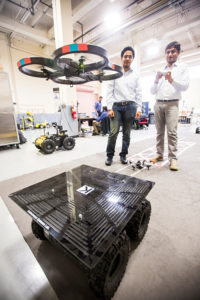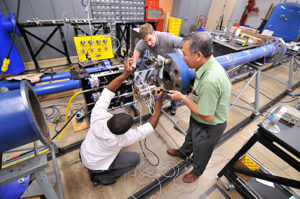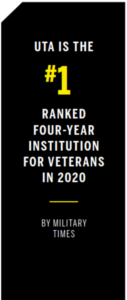STUDENTS ARE HELPING BOEING AND THE AIR FORCE SAFELY LEVERAGE LIGHTER AIRCRAFT
Since the 1800s (at least), the formal trial-and-error method has been the go-to discovery process for inventors.
Along the way, mostly since the 1960s, the aerospace industry started replacing metal parts with composite materials. In doing so, it’s been able to reduce aircraft weights by 20% to 40%.

The downside?
Science’s ability to develop advanced composite materials has outpaced its ability to quickly and inexpensively test them for safe use. The process of identifying and predicting weaknesses in advanced composite materials is still a work in progress. An unsettling thought, considering they’re used in both advanced military aircraft and commercial airliners.
That’s where the University of Texas at Arlington’s (UTA) Advanced Materials and Structures Lab (AMSL) team comes in.
“A known weakness of the existing progressive damage analysis methods is the lack of effective techniques to predict ultimate failure,” AMSL Director Andrew Makeev and fellow researchers Yuri Nikishkov and Dr. Guillaume Seon write in an article published in the April 2019 Journal of the American Helicopter Society.
Makeev and his team at UTA have spent years developing a new methodology that allows them to predict how certain composite materials will be affected by stress and fatigue, particularly in rotorcraft, such as helicopters, whose components experience severe stress. These predictions are based on advanced 3D CT scans and computer-generated structural-failure models.

The team presented its preliminary findings at the 72nd American Helicopter Society Forum on May 18, 2019, along with representatives from Sikorsky Aircraft and the U.S. Army Aviation Development Directorate.
Those results were part of an initiative by AMSL to form a Vertical Lift Consortium, which included experts from Sikorsky (a Lockheed Martin company) and was funded by the Army National Rotorcraft Technology Center.
“AMSL has been taking essential steps toward improving confidence in material qualification [safety testing] for laminated composites,” the team’s paper states.
The work of Dr. Makeev and his team at AMSL since roughly 2010 has attracted the attention and collaboration from several organizations, including:
-
-
- The Office of Naval Research, which in 2018 awarded the team two grants worth nearly $1.5 million; of that, a $930,000 grant will pay the team to study how the laws of physics impact manufacturing defects in composite materials; the other grant upgrades UTA’s scanning equipment, allowing AMSL researchers to examine material characterization at up to 1-micron resolution (a human hair, in contrast, is 75 microns wide)
- Sikorsky Aircraft Corp., which in 2015, awarded a $1.35 million grant to improve designs of composites to increase their durability
- Boeing, which in 2017 awarded AMSL a $600,000 grant to help Makeev and UTA Professor Endel Iarve further develop protocols for determining when composite components might fail. Iarve, a professor of mechanical and aerospace engineering in UTA’s Institute for Predictive Performance Methodologies, is serving as that project’s co-principal investigator.
-

“At the end of the research, Boeing and the Air Force want to understand and have confidence that our analysis can be used to predict the remaining useful life of composite airframe structures,” Dr. Makeev says in the spring 2018 issue of The University of Texas at Arlington Magazine.
The advances by AMSL and Makeev hold tremendous promise for the future of aviation, says Erian Armanios, chair of the UTA Department of Mechanical and Aerospace Engineering.
Armanios, in a news release, says that Makeev’s work helps the aircraft industry by improving sustainability, maintenance and life-cycle management.
“What Dr. Makeev is doing could have significant implications on aircraft design and certification,” Armanios says. “Developing a capability to predict composite airframe strength and durability is bound to have industry-wide implications.”
Peter Crouch, dean of the UTA College of Engineering, also in the news release, says, “It’s important for university researchers like Dr. Makeev to work hand-in-hand with companies to ensure that their work has impact beyond classroom walls, including helping our students land important jobs in those industry sectors.”
This article is part of the 2020 Higher Education Review Magazine.